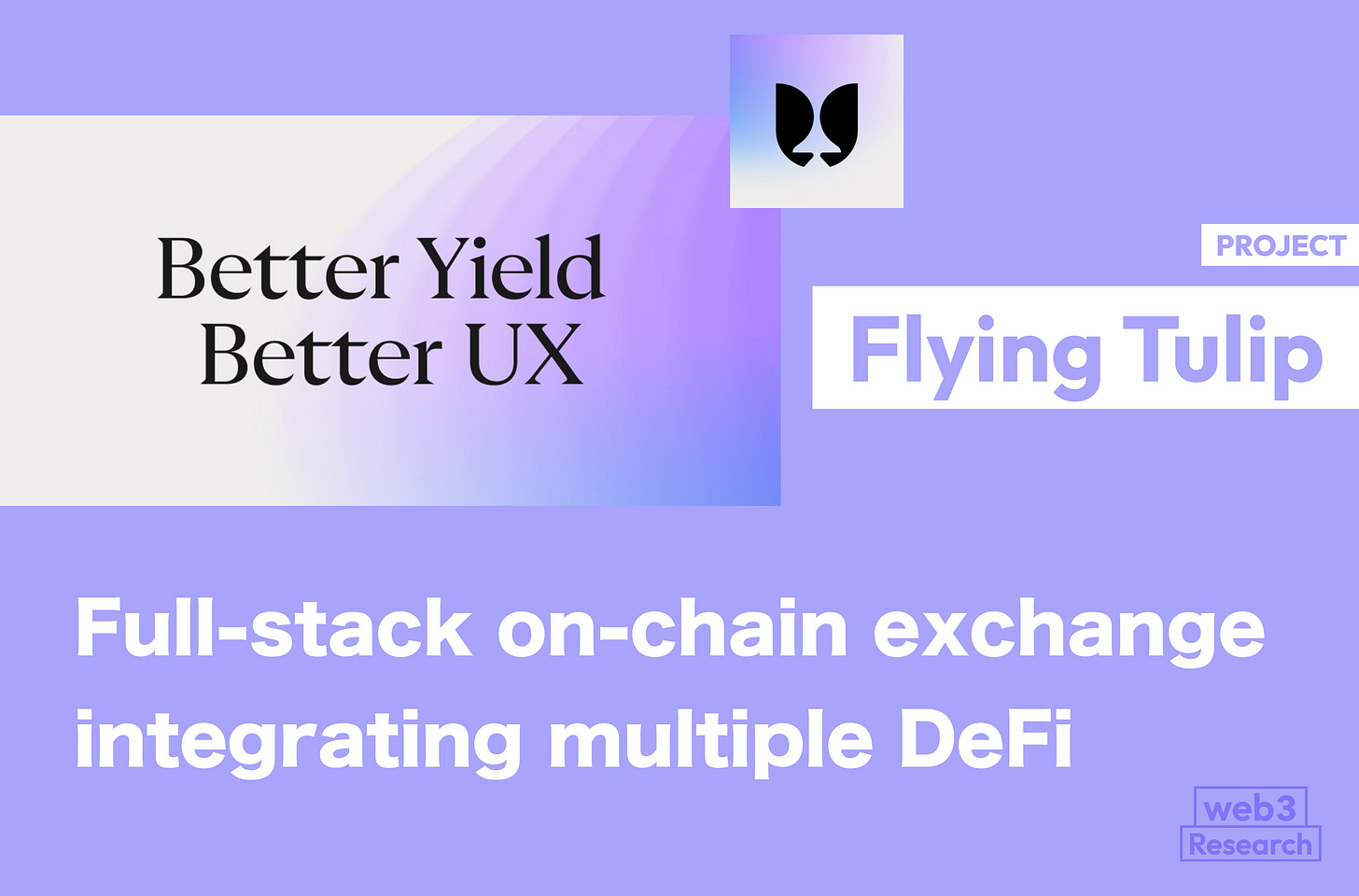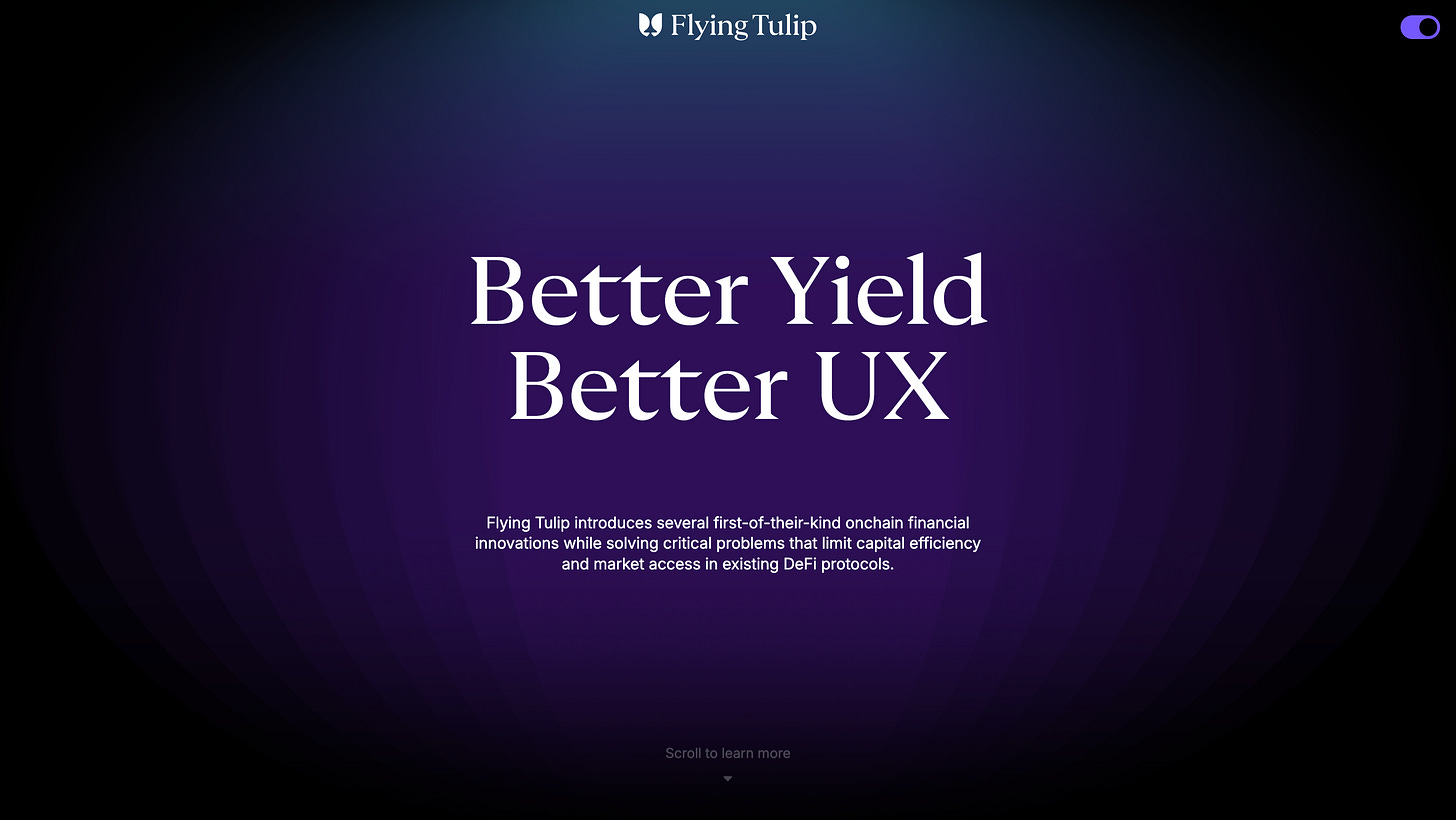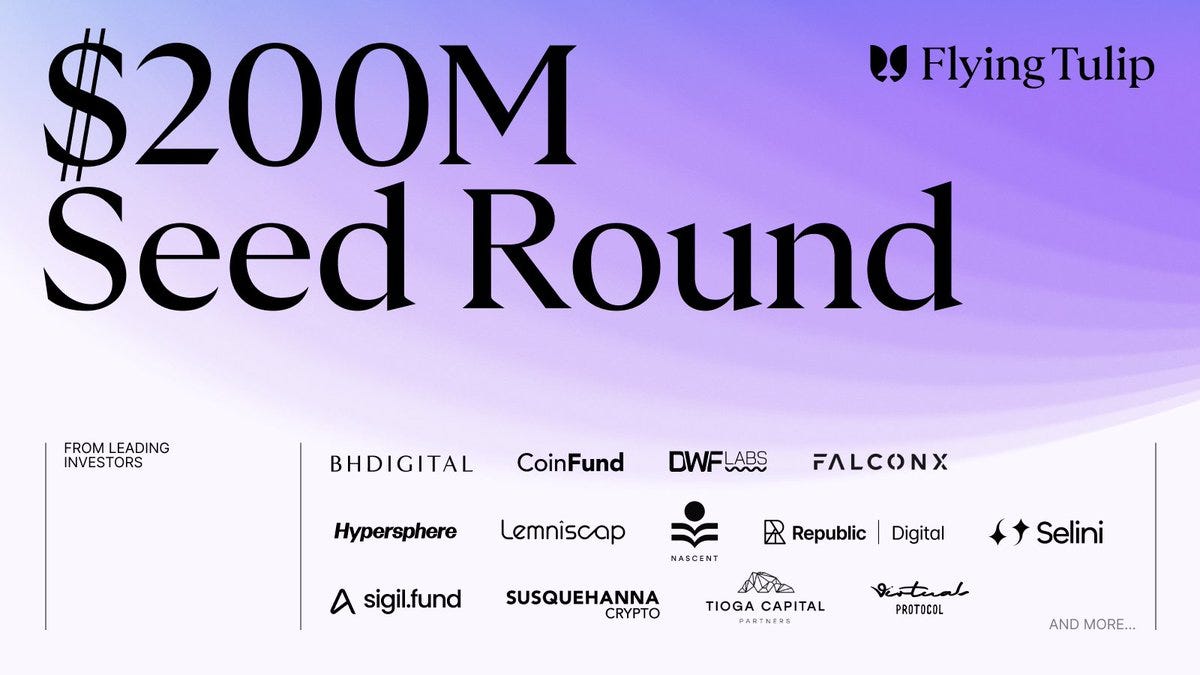【Flying Tulip】Full-stack on-chain exchange integrating multiple DeFi / Protocol uses only principal investment income from fundraising / @flyingtulip_
It is a distinctive token economy.
Good morning.
I am mitsui, a web3 researcher.
Today I researched Flying Tulip.
What is Flying Tulip?
Distinctive Financing and Token Economics
Will this be a new form of project?
🧵TL;DR
Andre Cronje-led “full stack” DeFi exchange. Integrates Lending/Cash/Deliveries/AMM/CLOB/Insurance/Stablecoin in a single cross margin, aiming for high capital efficiency and low cost by eliminating capital fragmentation.
Funding & Talk Nomics is unique: $200M seed -> up to $1B scale managed funded and operated and repurchased with investment income. Permanent on-chain redemption rights (return of principal) for $FT, zero initial team distribution + market buyback with proceeds -> deflationary design.
Functions to be offered include spot/futures and options (oracle-free design, high leverage), dynamic LTV lending, ftUSD, on-chain insurance, integrated LP& yield, etc. Plans are to start with Sonic and expand to Ethereum/Avalanche/BNB and other major EVMs.
What is Flying Tulip?
Flying Tulip is a new DeFi project by Andre Cronje, founder of Yearn Finance, and is a “full stack” on-chain exchange, so to speak, that integrates multiple DeFi services on a single platform.
Andre Cronje emphasized that Flying Tulip is not just a “DEX,” describing it as a “rebuilding from scratch” of the core DeFi primitives - lending, trading, AMM, CLOB, derivatives, insurance, and stablecoin - each with its own innovations They are.
In the background is the challenge of capital fragmentation faced by the existing DeFi infrastructure. In the current DeFi environment, users typically need to use separate platforms and collateral pools for lending, trading, and derivatives, which creates inefficiencies.
Flying Tulip’s integrated model aims to eliminate the need for multiple collateral silos through a single cross margin system, providing superior capital efficiency and lower transaction costs for sophisticated traders and institutional investors.
Although the full picture has not yet been released, the services and products to be offered are wide-ranging and encompass the major functions of the DeFi domain.
Cash transactions (spot transactions)A marketplace for physical trading of crypto assets such as Bitcoin and Ethereum; FlyingTulip offers this on the same liquidity pool as its other features, without the need to transfer funds.
Derivatives trading (perpetual futures, futures and options): Support for leveraged futures and options trading, enabling sophisticated trading strategies to be executed on-chain. In particular, highly leveraged perpetual futures contracts are expected to be offered, assuming leverage of up to 50x or more, and an independently designed oracle-free perpetual contract, independent of the price oracle, will also be introduced.
Lending (lending and borrowing)FlyingTulip features a dynamic loan-to-value (LTV) money market built in and flexible risk management based on asset volatility. The system features flexible risk management in response to asset volatility.
Native Stable Coin (ftUSD)The platform will issue its own USD-linked stablecoin, ftUSD, to serve as a reserve currency for settlement and collateral. ftUSD is designed to be delta-neutral to market price movements and is backed by a protocol infrastructure to dynamically manage liquidity and generate yields.
on-chain insuranceThe insurance product is also integrated: insurance against various risks in trading and lending. Users can obtain on-chain guarantees against risks that may occur within the protocol (e.g., liquidation risk, contract default, etc.).
Liquidity provision and yield farmingFlyingTulip: Users can participate in market making (LP) through a single, integrated liquidity pool. While in the past it was necessary to spread funds across AMMs, FlyingTulip will cover everything from spot to derivatives in a single pool, increasing capital efficiency. It will also offer a “structured yield product,” a composite management strategy using deposited assets, designed to give users access to sophisticated yield-farming opportunities.
All of these services interoperate on FlyingTulip to provide a consistent user experience. For example,Users make a one-time deposit of funds on a single platform, and the funds earned from cash transactions are used directly to margin derivatives transactionsThis makes it possible to do the following.
Also,All services integrated in a cross-margin mannerThe key feature of FlyingTulip is that it allows users to transfer assets between different products and make effective use of excess collateral. While previously it was necessary to transfer funds between protocols and manage individual collateral, FlyingTulip eliminates this complication and allows users to conduct all kinds of financial transactions in a “one-stop” manner.
These services will start with the Sonic chain, which Cronje is involved in running, and will be supported by major EVM chains such as Ethereum, Avalanche, and the BNB chain, with plans to gradually expand the number of supported chains.
Distinctive Financing and Token Economics
Flying Tulip has not yet released its product to the public and is in the process of announcing a $200M seed round of funding at the end of September 2025.
Although it is a serial entrepreneur, raising $200M in seed is quite huge. In addition, “Flying Tulip” is looking to raise $800M in a public sale in the future, for a total of $10M in funding.
In fact, this financing and the token economics tied to it are most distinctive.
Flying Tulip will issue a native token called $FT (Flying Tulip Token), which will be distributed to all participants in the fundraising, including investors.
The funds raised will be positioned as a “reserve and operating fund” to support the long-term operations of the protocol and will be allocated on-chain to operating platforms such as Aave, Spark and Ethena to invest in secure yield strategies.
The target average yield is estimated to be about 4% per year, which means that if a total of $1 billion in funds could be invested, it would generate about $40 million per year in profit. This profit will be the engine that will provide a continuous supply of funds to operate the project and to repurchase tokens.
In other words, the protocol is to invest the protocol using only investment income without touching the principal, even though it is called fundraising.
Purchasers of $FT tokens will receive a “On-chain redemption rights (perpetual put)The “$FT Token” is granted and can be used to refund an amount equivalent to the principal amount originally invested in the same asset at that time by burning the $FT Token on hand at any time.
For example, if an investor invests in ETH and receives $FT, he/she can withdraw up to the amount of ETH initially invested if he/she burns the $FT at a later date. The underlying funds are reserved in an on-chain “reserve and operating fund” consisting of the funds raised, which is automatically cleared and paid out by the smart contract.
This design makes $FT tokens “downside risk limited to principal and upward potential open to infinity” for investors, facilitating secure long-term ownership and participation.
Cronje describes this mechanism as “providing unlimited upside potential while maintaining a safety net at all times,” and it is intended to greatly alleviate the anxiety associated with traditional token investments (the possibility of a near-zero drop in token value in the event of project failure).
He further explained that his own past experiences, such as with Yearn and Sonic, have taught him that projects tend to be forced to make short-term oriented decisions when faced with falling token prices, and that FlyingTulip has been designed to alleviate that pressure so that he can focus on product development from the hip. FlyingTulip has learned from past experience that projects tend to be short-term oriented in the face of falling token prices.
The token distribution and incentive design is also unique.
We have a policy of not distributing any initial tokens to the team (founding members), and the management is compensated only through $FT repurchases on the market, funded in part by protocol revenue.
This means that the team can only increase its token holdings by buying tokens from the market with the revenue generated by the successful completion of the project. Conversely, if the project does not produce results, the team will not earn token rewards.
This model, which directly links incentives to actual use and long-term performance, is designed to ensure a strong alignment of interests between the founding team and investors/users. In fact, 100% of all tokens distributed initially in FlyingTulip will be held by investors, and there will be no initial allocation to teams or foundations.
Thereafter, as tokens repurchased from the market with protocol proceeds are transferred to foundation or burn addresses, the supply of tokens in circulation will diminish over time, and eventually the majority of tokens may be burned.
Furthermore, when an investor sells a $FT token in the secondary market, the redemption right attached to the token is extinguished and the corresponding principal is transferred to the project side (foundation) to be promptly used to repurchase/burn the token. Therefore, the more investors sell in the market, the less tokens are circulated, and the selling pressure conversely reinforces the token deflation mechanism.
As described above, FlyingTulip’s business model is
Guarantee of long-term operations by securing large sums of funds
Trust building through tokens with investor protection
Revenue-linked incentives to align team and user interests
The three pillars of this model are The aim of this model is to mature the product with sufficient time and resources, avoiding the vicious cycle that other projects tend to face due to depletion of funds and short life span, and stagnant token prices.
Will it be a new form of project
The final section is a summary and discussion.
First of all, I believe that there will be more all-in-one DeFi platforms that combine all DeFi functions into one, and I strongly feel that this is a possibility. Furthermore, it is interesting to note that we are not simply embedding and building only the front end in-house, but rather designing everything from scratch and rebuilding it after taking liquidity and capital efficiency into account.
Also, what I personally find interesting is still the funding and token economics perspective, and I believe that more teams will adopt this structure in the future.
We have previously proposed the way token economics should be: growth tokens next to governance utilities, but while token incentives can help with the initial boost, there is a lot of uncertainty about how they will be handled after that.
Therefore, we believe that a gradual decrease in supply as the project grows makes sense as a way of life.
FlyingTulip’s model is truly designed with a decreasing supply, plus an asset-backed feature with a minimum principal repayment. This structure makes it much easier for investors to participate.
Also, there are no hidden allocations, and increases and decreases in supply are easily predictable, making it easier to forecast prices in secondary distribution.
I am very much looking forward to future public sales and project launches, although I wonder how they will create liquidity and such if they are going to give 100% to investors. If this works well, I think we will see more and more funding methods that learn from this.
This is the research for FlyingTulip!
Reference Link:HP / X
Disclaimer:I carefully examine and write the information that I research, but since it is personally operated and there are many parts with English sources, there may be some paraphrasing or incorrect information. Please understand. Also, there may be introductions of Dapps, NFTs, and tokens in the articles, but there is absolutely no solicitation purpose. Please purchase and use them at your own risk.
About us
🇯🇵🇺🇸🇰🇷🇨🇳🇪🇸 The English version of the web3 newsletter, which is available in 5 languages. Based on the concept of ``Learn more about web3 in 5 minutes a day,'' we deliver research articles five times a week, including explanations of popular web3 trends, project explanations, and introductions to the latest news.
Author
mitsui
A web3 researcher. Operating the newsletter "web3 Research" delivered in five languages around the world.
Contact
The author is a web3 researcher based in Japan. If you have a project that is interested in expanding to Japan, please contact the following:
Telegram:@mitsui0x
*Please note that this newsletter translates articles that are originally in Japanese. There may be translation mistakes such as mistranslations or paraphrasing, so please understand in advance.




